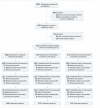Long-term nicotine replacement therapy: a randomized clinical trial
- PMID: 25705872
- PMCID: PMC4410859
- DOI: 10.1001/jamainternmed.2014.8313
Long-term nicotine replacement therapy: a randomized clinical trial
Abstract
Importance: The US Food and Drug Administration adopted labeling for nicotine patches to allow use beyond the standard 8 weeks. This decision was based in part on data showing increased efficacy for 24 weeks of treatment. Few studies have examined whether the use of nicotine patches beyond 24 weeks provides additional therapeutic benefit.
Objective: To compare 8 (standard), 24 (extended), and 52 (maintenance) weeks of nicotine patch treatment for promoting tobacco abstinence.
Design, setting, and participants: We recruited 525 treatment-seeking smokers for a randomized clinical trial conducted from June 22, 2009, through April 15, 2014, through 2 universities.
Interventions: Smokers received 12 smoking cessation behavioral counseling sessions and were randomized to 8, 24, or 52 weeks of nicotine patch treatment.
Main outcomes and measures: The primary outcome was 7-day point prevalence abstinence, confirmed with breath levels of carbon monoxide at 6 and 12 months (intention to treat).
Results: At 24 weeks, 21.7% of participants in the standard treatment arm were abstinent, compared with 27.2% of participants in the extended and maintenance treatment arms (χ(2)(1) = 1.98; P = .17). In a multivariate model controlled for covariates, participants in the extended and maintenance treatment arms reported significantly greater abstinence rates at 24 weeks compared with participants in the standard treatment arm (odds ratio [OR], 1.70 [95% CI, 1.03-2.81]; P = .04), had a longer duration of abstinence until relapse (β = 21.30 [95% CI, 10.30-32.25]; P < .001), reported smoking fewer cigarettes per day if not abstinent (mean [SD], 5.8 [5.3] vs 6.4 [5.1] cigarettes per day; β = 0.43 [95% CI, 0.06-0.82]; P = .02), and reported more abstinent days (mean [SD], 80.5 [38.1] vs 68.2 [43.7] days; OR, 1.55 [95% CI, 1.06-2.26]; P = .02). At 52 weeks, participants in the maintenance treatment arm did not report significantly greater abstinence rates compared with participants in the standard and extended treatment arms (20.3% vs 23.8%; OR, 1.17 [95% CI, 0.69-1.98]; P = .57). Similarly, we found no difference in week 52 abstinence rates between participants in the extended and standard treatment arms (26.0% vs 21.7%; OR, 1.33 [95% CI, 0.72-2.45]; P = .36). Treatment duration was not associated with any adverse effects or adherence to the counseling regimen, but participants in the maintenance treatment arm reported lower adherence to the nicotine patch regimen compared with those in the standard and extended treatment arms (mean [SD], 3.94 [2.5], 4.61 [2.0], and 4.7 [2.4] patches/wk, respectively; F2,522 = 6.03; P = .003).
Conclusions and relevance: The findings support the safety of long-term use of nicotine patch treatment, although they do not support efficacy beyond 24 weeks of treatment in a broad group of smokers.
Trial registration: clinicaltrials.gov Identifier: NCT01047527.
Figures


Comment in
-
Nicotine Replacement Therapy as a Maintenance Treatment.JAMA. 2015 Aug 18;314(7):718-9. doi: 10.1001/jama.2015.7460. JAMA. 2015. PMID: 26284723 Free PMC article.
References
-
- Shiffman S, Brockwell SE, Pillitteri JL, Gitchell JG. Use of smoking-cessation treatments in the United States. Am J Prev Med. 2008;34(2):102–111. - PubMed
-
- Fiore MC, Jaen CR, Baker TB, et al. Treating Tobacco Use and Dependence: 2008 Update. US Public Health Service; Rockville, MD: 2008. US Public Health Service Clinical Practice Guideline.
-
- Stead LF, Perera R, Bullen C, et al. Nicotine replacement therapy for smoking cessation. Cochrane Database Syst Rev. 2012;11:CD000146. - PubMed
Publication types
MeSH terms
Substances
Associated data
Grants and funding
LinkOut - more resources
Full Text Sources
Other Literature Sources
Medical
Miscellaneous

